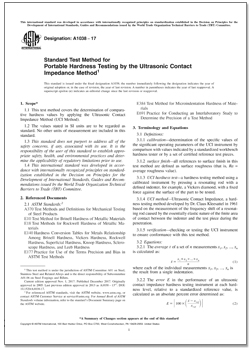英文名稱:
ASTM A956-17a
Standard Test Method for Leeb Hardness Testing of Steel Products
中文名稱:
ASTM A956-17a
鋼質(zhì)產(chǎn)品里氏硬度試驗標(biāo)準(zhǔn)試驗方法
替代情況:
替代ASTM A956-17
代號說明:
This standard is issued under the fixed designation A956/A956M; the number immediately following the designation indicates the year of original adoption or, in the case of revision, the year of last revision. A number in parentheses indicates the year of last reapproval.
A superscript epsilon (ε) indicates an editorial change since the last revision or reapproval.
版本說明:
1 This test method is under the jurisdiction of ASTM Committee A01 on Steel, Stainless Steel and Related Alloys and is the direct responsibility of Subcommittee A01.06 on Steel Forgings and Billets.
Current edition approved Nov. 1, 2017. Published December 2017. Originally approved in 1996. Last previous edition approved in 2017 as A956/A956M – 17.
Leeb and Equotip are registered trademarks used with permission of Proceq SA. DOI: 10.1520/A0956_A0956M-17A.
2 For referenced ASTM standards, visit the ASTM website, www.astm.org, or contact ASTM Customer Service at service@astm.org. For Annual Book of ASTM Standards volume information, refer to the standard’s Document Summary pageon the ASTM website.
標(biāo)準(zhǔn)正文:
1. Scope
1.1 This test method covers the determination of the Leeb hardness of steel, cast steel, and cast iron (Part A), including the methods for the verification of Leeb hardness testing instruments (Part B), and the calibration of standardized test blocks (Part C).
NOTE 1—The original title of this standard was “Standard Test Method for Equotip Hardness Testing of Steel Products.”
1.2 The values stated in either SI units or inch-pound units are to be regarded separately as standard. The values stated in each system may not be exact equivalents; therefore, each system shall be used independently of the other. Combining values from the two systems may result in non-conformance with the standard.
1.3 This standard does not purport to address all of the safety concerns, if any, associated with its use. It is the responsibility of the user of this standard to establish appropriate safety, health, and environmental practices and determine the applicability of regulatory limitations prior to use.
1.4 This international standard was developed in accordance with internationally recognized principles on standardization established in the Decision on Principles for the
Development of International Standards, Guides and Recommendations issued by the World Trade Organization Technical Barriers to Trade (TBT) Committee.
2. Referenced Documents
2.1 ASTM Standards:
E140 Hardness Conversion Tables for Metals Relationship Among Brinell Hardness, Vickers Hardness, Rockwell Hardness, Superficial Hardness, Knoop Hardness, Scleroscope Hardness, and Leeb Hardness
E177 Practice for Use of the Terms Precision and Bias in ASTM Test Methods
E691 Practice for Conducting an Interlaboratory Study to Determine the Precision of a Test Method
3. Terminology
3.1 Definitions:
3.1.1 calibration—determination of the values of the significant operating parameters of the instrument by comparison with values indicated by a reference instrument or by a set of reference standards.
3.1.2 Leeb hardness number—a number equal to the ratio of the rebound velocity to the impact velocity of a 0.118 in. [3 mm] or 0.197 in. [5 mm] (based on the type of impact
device) diameter spherically shaped tungsten carbide, silicon nitride, or diamond tipped impact body, multiplied by 1000.
L=Rebound Velocity/Impact Velocity*1000
The Leeb hardness number is followed by the symbol HL with one or more suffix characters representing the type of impact device.
3.1.3 Leeb hardness test—a dynamic hardness test method using a calibrated instrument that impacts a spherically shaped tungsten carbide, silicon nitride, or diamond tipped body with a fixed velocity (generated by a spring force) onto a surface of the material under test. The ratio of the rebound velocity to the impact velocity of the impact body is a measure of the hardness of the material under test.
3.1.4 surface finish—all references to surface finish in this test method are defined as surface roughness (that is, Ra = average roughness value, AA = arithmetic average).
3.1.5 verification—checking or testing the instrument to ensure conformance with this test method.
在線閱讀 免費下載







